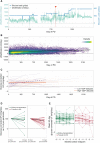Monitoring Daily Ultrafiltration in Automated Peritoneal Dialysis
- PMID: 34893504
- PMCID: PMC8763167
- DOI: 10.2215/CJN.08180621
Monitoring Daily Ultrafiltration in Automated Peritoneal Dialysis
Keywords: chronic dialysis; peritoneal dialysis; peritoneal membrane; ultrafiltration.
Figures

References
-
- Davies SJ: Peritoneal dialysis—Current status and future challenges. Nat Rev Nephrol 9: 399–408, 2013 - PubMed
-
- Brown EA, Blake PG, Boudville N, Davies S, de Arteaga J, Dong J, Finkelstein F, Foo M, Hurst H, Johnson DW, Johnson M, Liew A, Moraes T, Perl J, Shroff R, Teitelbaum I, Wang AY, Warady B: International Society for Peritoneal Dialysis practice recommendations: Prescribing high-quality goal-directed peritoneal dialysis. Perit Dial Int 40: 244–253, 2020 - PubMed
-
- Rogovoy NM, Howell SJ, Lee TL, Hamilton C, Perez-Alday EA, Kabir MM, Zhang Y, Kim ED, Fitzpatrick J, Monroy-Trujillo JM, Estrella MM, Sozio SM, Jaar BG, Parekh RS, Tereshchenko LG: Hemodialysis procedure-associated autonomic imbalance and cardiac arrhythmias: Insights from continuous 14-day ECG monitoring. J Am Heart Assoc 8: e013748, 2019 - PMC - PubMed
-
- Johnson DW, Brown FG, Clarke M, Boudville N, Elias TJ, Foo MW, Jones B, Kulkarni H, Langham R, Ranganathan D, Schollum J, Suranyi MG, Tan SH, Voss D; balANZ Trial Investigators : The effect of low glucose degradation product, neutral pH versus standard peritoneal dialysis solutions on peritoneal membrane function: The balANZ trial. Nephrol Dial Transplant 27: 4445–4453, 2012 - PMC - PubMed
-
- Morelle J, Stachowska-Pietka J, Öberg C, Gadola L, La Milia V, Yu Z, Lambie M, Mehrotra R, de Arteaga J, Davies S: ISPD recommendations for the evaluation of peritoneal membrane dysfunction in adults: Classification, measurement, interpretation and rationale for intervention. Perit Dial Int 41: 352–372, 2021 - PubMed
Publication types
MeSH terms
LinkOut - more resources
Full Text Sources

